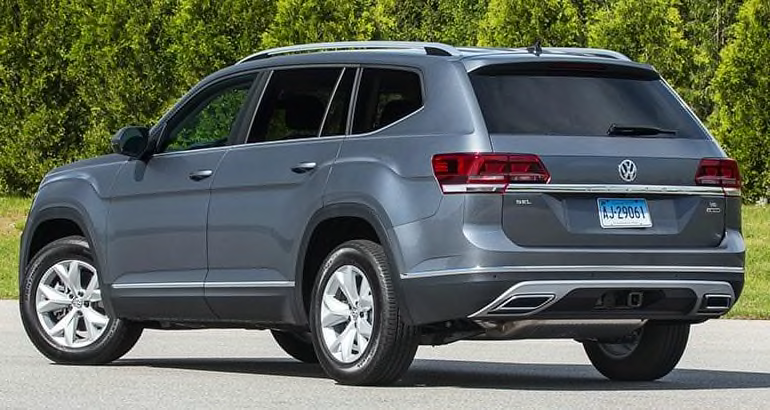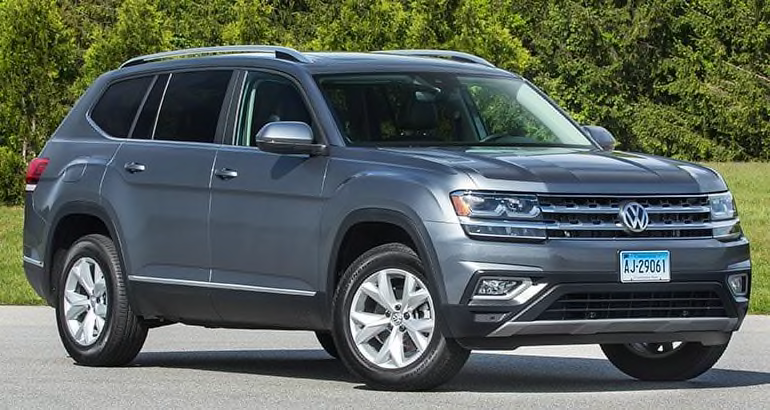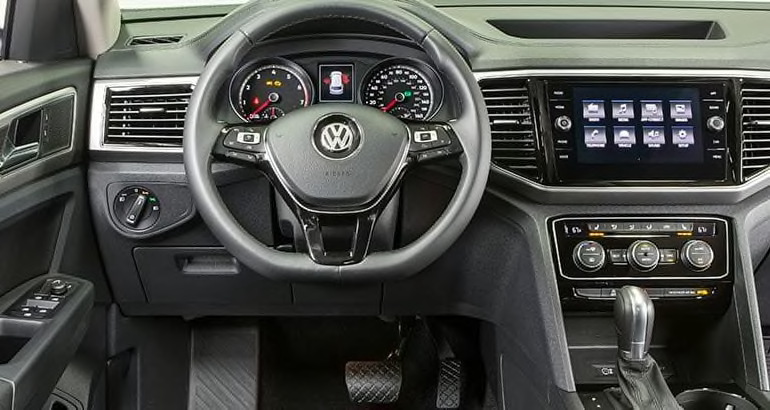For years Volkswagen chose to market European-developed, driver-focused vehicles at a premium price rather than build the larger, more vanilla vehicles its competitors offered. The manufacturer approached the American car market in its own way rather than follow the herd.
But to become more than a bit player, VW had to grow and diversify its model line by catering to the tastes of the American buyer. This was seen initially with the Jetta and Passat sedans, and now with the brand-new 2018 Volkswagen Atlas.
After spending a few weeks with our own 2018 Atlas, it's clear VW built an ultra-functional, family-friendly three-row SUV. From the comfortable ride and powerful engine to the roomy, feature-laden interior, the Atlas has the chops to take on competitors such as the Chevrolet Traverse, Honda Pilot, and Toyota Highlander. Just don't expect the dynamic handling or near-luxury materials found in past VWs. Those went away as part of Volkswagen's Americanization process.
Given the time it took for VW to enter the hot segment, you might call this model the Volkswagen At-last. If ever a brand needed a large three-row SUV, it was VW. (Yes, Subaru likewise has a three-row-SUV hole to fill in its portfolio, soon to be plugged with the upcoming Ascent.)
For now, all versions of the new Atlas come with a single engine and transmission combo: a 276-hp, 3.6-liter V6 mated to an eight-speed automatic. Front-wheel drive is standard, with VW's 4Motion all-wheel-drive system available with every trim. A 235-hp, 2.0-liter turbocharged four-cylinder will be available later this year, but only with front-wheel drive.
While the most basic version starts at $33,500, we purchased a 2018 Volkswagen Atlas SEL with 4Motion, priced at $42,690. Throw in a few dealer-installed features such as a cargo-area liner, wheel locks, and a roadside assistance kit, and the MSRP came to $44,165, including destination. VW expect the SEL 4Motion to make up the majority of sales.

Out on the road the big Volkswagen Atlas is relatively unremarkable, but competent. The ride is firm and quite comfortable, although on uneven pavement the Atlas has a hard time dealing with the mixed surfaces. As a result, passengers are bounced around a bit. However, VW clearly got noise suppression right. The cabin is luxury-SUV quiet, almost on par with the Audi Q7.
But Volkswagen most clearly benchmarked the Honda Pilot and Toyota Highlander in terms of handling. There is no semblance of Volkswagen's traditional, sporty DNA in the Atlas. Rather, it feels like the big, overgrown coach that it is. Handling is not tight, done in by the slow, overly light steering. There's nothing alarming about the handling—it's just boring. Nobody will mistake the Atlas as being a bigger version of the two-row Touareg SUV.
The powertrain, however, is a bright spot. The V6 and eight-speed automatic work well together, forming a smooth, punchy combination that delivers plenty of motivation. Toyota should take note of the transmission; it is far more responsive than the unit found in the freshened Highlander (and Sienna minivan).
Advanced safety gear, including forward-collision warning and automatic emergency braking, are standard on the SE with the Tech package, as well as on the SEL and SEL Premium. But these features aren't available on the base S trim.

Volkswagen's product Americanization continues inside the Atlas. But unlike the cut-rate Jetta and bland Passat sedans, the effort is better executed. Like the rest of the vehicle, the driving position is quite big and roomy. There's a ton of space around the footwell, and knee and legroom is abundant. Visibility is good all around, thanks to the Atlas' blocky styling. Windows are large and the roof pillars are small, helping matters immensely.
Up front, driver and passenger are treated to large seats that feature a wide range of adjustments, although power lumbar support is only in/out. So far, we've found that the Atlas' seats are comfortable for long-distance trips, but their support isn't quite up to the standard set by past VW products.
With many large SUVs, the controls are spread across the dashboard, as if designers felt compelled to use every possible inch available. Refreshingly, that isn't the case with the Atlas. Drivers both tall and short found the controls close at hand and easy to access.
The touch-screen infotainment system is straightforward to use, with a clear display and big buttons and fonts. Volkswagen has redundant buttons for accessing submenus, and presets are always displayed. We also appreciate that there are both volume and tuning knobs. It's such a good system, in fact, that Honda and Toyota should pick up an Atlas or two for benchmarking. There is just one small issue—the screen is supposed to sense when a hand is approaching and open a small menu at the bottom of the screen. This feature is a bit slow to respond.

The 6.5- and 8-inch screen systems support Android Auto and Apple Carplay, as well as MirrorLink. This is welcome, as it makes the Atlas relatively "future-proof." Instead of being stuck with costly map updates and out-of-trend internet radio apps, those features will help keep the car's connected environment up to date.
Pairing a phone is an easy process, and the system quickly recognizes when a paired phone returns to the Atlas. Shortcuts on the steering wheel make it easy to access the contacts list, and the use of natural voice recognition makes hands-free calling a snap.
Volkswagen has built an SUV that can compete with a minivan for second- and third-row accommodations. The three-person, second-row bench seat in our Atlas can easily accommodate adults for long trips. There is plenty of toe, leg, knee, and headroom, even in the middle seating position. The seatbacks can recline in a 60/40 split, and they can be lowered, creating a flat cargo floor. Second-row passengers have access to a 115V power outlet, as well as two high-power USB charging ports. Passengers in the center position sit on a bit of a perch, and the backrest (which is the underside of the center armrest) is very firm. That stands in stark contrast to the outboard seats. Both provide decent leg support, but the seat cushions—particularly the backrest—are quite soft.
The VW shines when you need to move the second-row seat out of the way to get into the third row, outdoing the entire industry in available space.
Pull a lever on the seatback (on either side of the car), and it pivots forward, then slides toward the front of the car—even with a child seat installed. The result is a passageway large enough for a 6-foot-tall adult to climb through with ease. It's such a wide space that only the largest of adults will rub against the door frame or folded seatback. Children will have no problem scrambling to the third-row seat.
That third row is quite large—big enough to accommodate two adults for short trips. There is a well-defined cutout under the second-row seat that provides adequate toe room for people in the way back. And because the second row can slide fore/aft in the same 60/40 split, a fair balance can be struck between legroom for the second- and third-row passengers.
Folding down all of the seats provides a wide, flat, and gargantuan cargo space. Where the Volkswagen Atlas can't match up with a minivan comes when the third row is raised; the VW lacks the deep well that minivan seats tumble into. Still, there is room behind the raised third-row seat for plenty of grocery bags or other merchandise.
SEL and SEL Premium V6 versions also come with a standard tow hitch, although it requires a special adaptor for 4- or 7-pin trailer connections.
While it has been a long wait for VW to offer an American-grade three-row SUV, the Atlas ticks all the boxes for a suburban, family-focused model, with plenty of passenger room, abundant cargo space, and enough charging capacity for all your digital devices. It remains to be seen how well it competes in our road tests, as well as in terms of reliability.
Check back at CR.org later this summer for full results from our in-depth road test program.


















